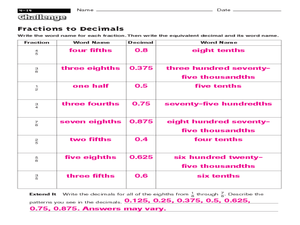Curated OER
Prime Factorizations - Post Test
In this prime factorizations worksheet, students complete a set of 10 multiple choice questions. Students may print out the test or click on a link to see answers.
Curated OER
And Yet Another Number Patterns Challenge
For this number patterns worksheet, students solve 10 problems in which a sequence of 7 numbers is analyzed and the pattern determined. Students continue the pattern and write the next two numbers.
Curated OER
Challenge: Fractions to Decimals
In this fractions worksheet, pupils write the word name and decimal for each fraction given. They complete eight fraction to decimals problems.
Curated OER
Make Ten Guided Lesson
Use these missing-addend problems to help your beginning mathematicians practice addition facts. They read sentences and solve, making 10 from different single-digit numbers. Each of these four problems is formatted differently, so the...
Curated OER
I Can Use a Worm to Count
Kindergarteners use worms, puppets or other props to practice counting to 100. First, they listen to a read aloud of Count Worms by Roger Hargeaves. A worm pattern is used to count to 100, with each segment of the worm...
Curated OER
Math Series
Even though this activity is just a simple review of estimation, it is a fast and easy way to explore this topic. Young mathematicians estimate the number of items contained in two jars and discuss their answers. Afterwards, they can use...
Norm Mitchell
Quiz: Representing, Comparing, and Ordering Decimals
Here is a 42-question quiz dealing with decimals to the thousandths place. It is comprehensive in that it has test takers use inequality signs to compare pairs of decimal numbers, choose the least- or greatest-valued nubmer out of a set...
Curated OER
Addition Patterns
Use a learning activity with your youngsters in order to establish an understanding of patterns in a small addition table. Help learners recognize that adding two odd numbers will produce an even number, and adding two even numbers will...
Curated OER
Identifying Patterns
Investigators examine the clues to complete 17 sequences by skip counting backwards. There are two examples to get them started, and all of these patterns include the first three numbers but are missing the last five. If you want...
Curated OER
Comparing Fractions and Equivalence
Which fraction is greater than? Less than? There are 10 problems here that give scholars a visual approach to comparing fractions. They start by writing the fractions represented in a shaded shape. Then, they begin comparing visual...
Curated OER
Hundreds, Tens, and Units
How many hundreds, tens, and ones are there? The class examines 3 different images, each containing flats, rods, and units. They write down the number of 100s, 10s, and 1s, then the whole number they represent.
Curated OER
Counting to 100: Step-by-Step
Introduce your pupils to the hundreds chart! This pair of worksheets is designed to walk them through the patterns they see in the chart as they count by ones and 10s. They fill in missing numbers on a hundreds chart, using guided steps....
DK Publishing
Sneaky Snakes: Counting, Part 2
Hissss! Practice counting forwards and backwards with a sly assignment. Eight snakes feature number sequences that are missing a few numbers. The beginning numbers vary, and some snakes require counting down. Learners write in the...
DK Publishing
Stars and Planets Connect the Dots
Reach for the stars with this cute connect-the-dots activity! Kindergartners practice their counting and number sequencing by connecting the numbers 1 through 6 or 10 in four different shapes. A rocketship is completed for them as an...
abcteach
Learning Number Words in Spanish
Combine Spanish vocabulary with a little bit of math. Learners practice the numbers one through twelve in Spanish by completing the sentences on the page. Various other vocabulary words are included in each sentence.
Curated OER
Array Picture Cards
Arrays are a visual way to practice multiplication and division. Using one of these twelve array picture cards, learners write a multiplication word problem describing what they see. After also recording a multiplication number sentence,...
Maths Blog
Adding/Subtracting Whole Numbers in Your Head
Exercise those mental math muscles! This worksheet contains 10 addition and 10 subtraction problems which require learners to compute sums or differences in their heads. A quick review at the top of the page provides a strategy based on...
Curated OER
Explorations 5: Introduction to Limits
In this limit worksheet, students find the interval values of given functions. They identify constants, and plot graphs. This three-page worksheet contains approximately 20 problems.
Coloring Squared
Memorial Day Soldiers
Practice division and celebrate Memorial Day with a color-by-number problem solving worksheet. The final picture includes a group of Memorial Day soldiers.
Coloring Squared
Baseball Player Comparing Unlike Fractions
Hit unlike fractions out of the park in a comparing fractions color by number (symbol) worksheet. Young mathematicians place <, >, or = to make each comparing sentence true. Then, they use a key to color accordingly. When complete,...
Coloring Squared
Thanksgiving Pilgrim—Holiday Subtraction
What's the mystery picture? Pupils solve the subtraction problems in each square. Then they use the key at the bottom to determine the color of the square.
EngageNY
The Division Algorithm—Converting Decimal Division into Whole Number Division Using Mental Math
Make math much simpler with mental math methods. The 16th installment in a series of 21 looks at ways scholars can apply mental math to convert division problems into easier problems with the same quotient. Multiplying or dividing both...
Mathematics Assessment Project
Middle School Mathematics Test 5
A middle school test contains two 40-minute sections covering material through algebra. All questions involve applied problem solving or mathematical analysis.
EngageNY
Multiplication of Numbers in Exponential Form
Develop a solid understanding of multiplication and division properties of exponents. Individuals expand exponential terms to discover the patterns and create the properties in the second installment in a series of 15. The activity...























